West Hartford’s First Steps to Speed Cameras – A Vision of Zero Fatalities

Audio By Carbonatix
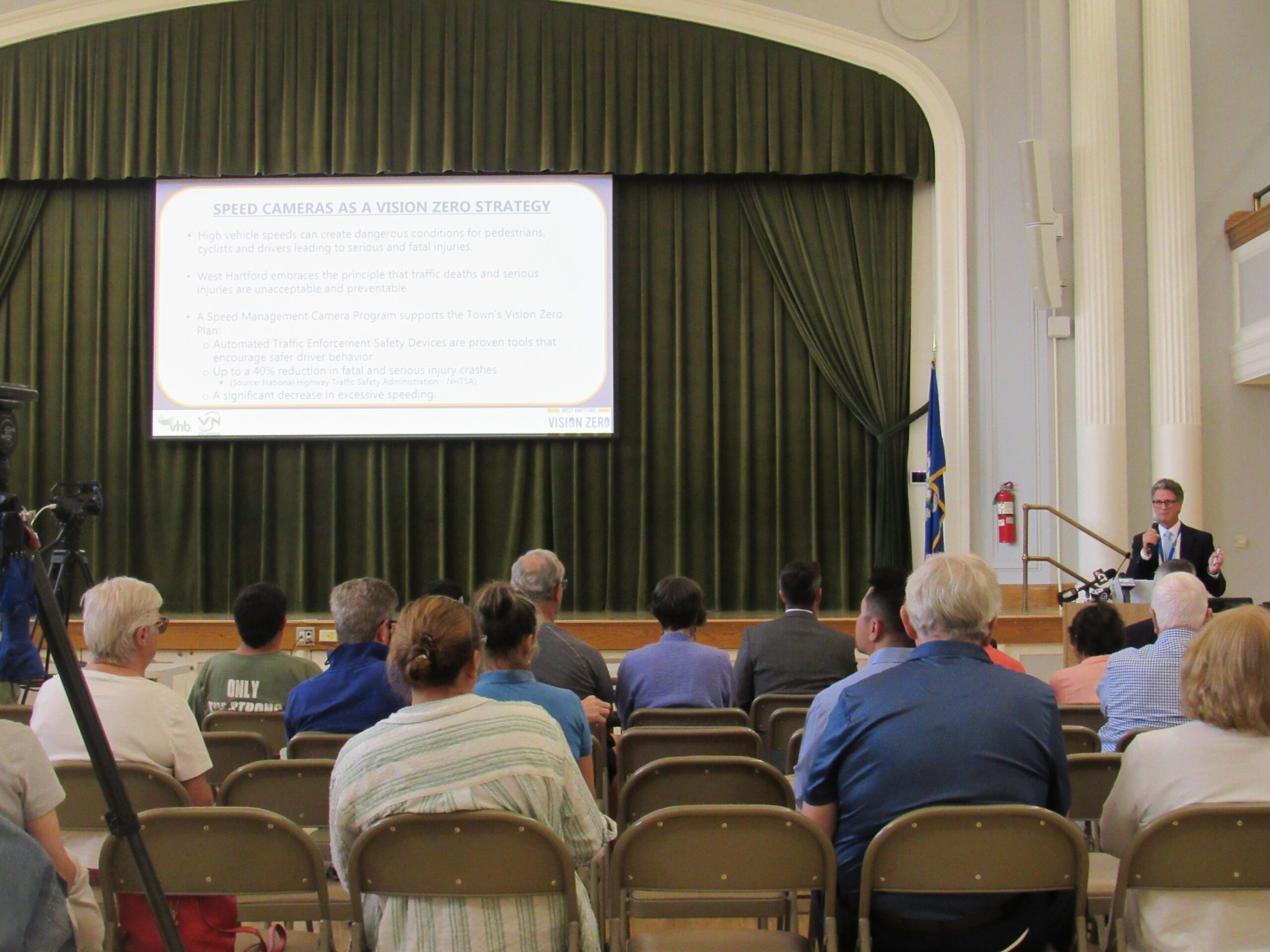
Town Manager Rick Ledwith speaks to the crowd at a public forum on July 30, 2025. West Hartford Vision Zero – speed management camera program (public meeting), July 30, 2025. Photo credit: Mia Jaworski
Town officials and engineers presented a plan to install 15 speed cameras across West Hartford as part of its Vision Zero effort to end traffic deaths and injuries – marking the first major step in this specific initiative intended to support safer streets.
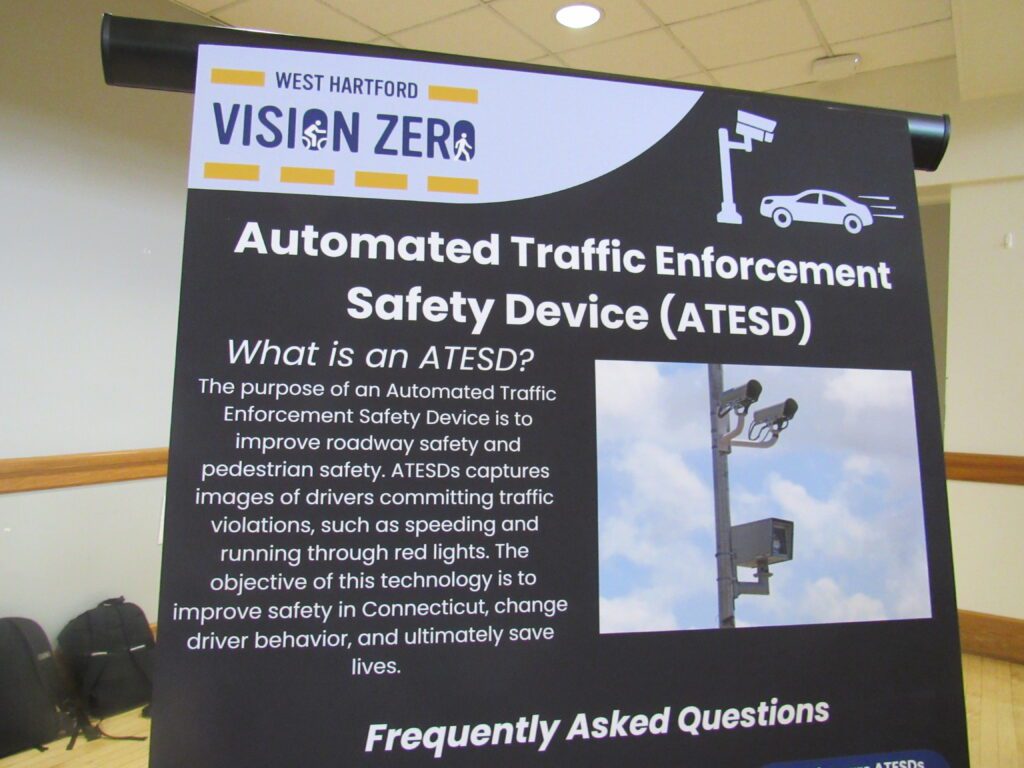
West Hartford Vision Zero – speed management camera program (public meeting), July 30, 2025. Photo credit: Mia Jaworski
By Mia Jaworski and Roz Green
The Town of West Hartford, along with consultant VHB & VN Engineers hosted a public meeting Wednesday night to present and gather feedback on the town’s proposed Speed Management Camera Program, marking an important step in implementing automated traffic enforcement as part of its broader Vision Zero initiative.
The automated enforcement program, which is designed to curb high vehicle speeds and reduce dangerous driving behaviors, supports West Hartford’s Vision Zero Action Plan – a long-term and multi-faceted commitment to eliminate all fatal and serious car crashes by 2033.
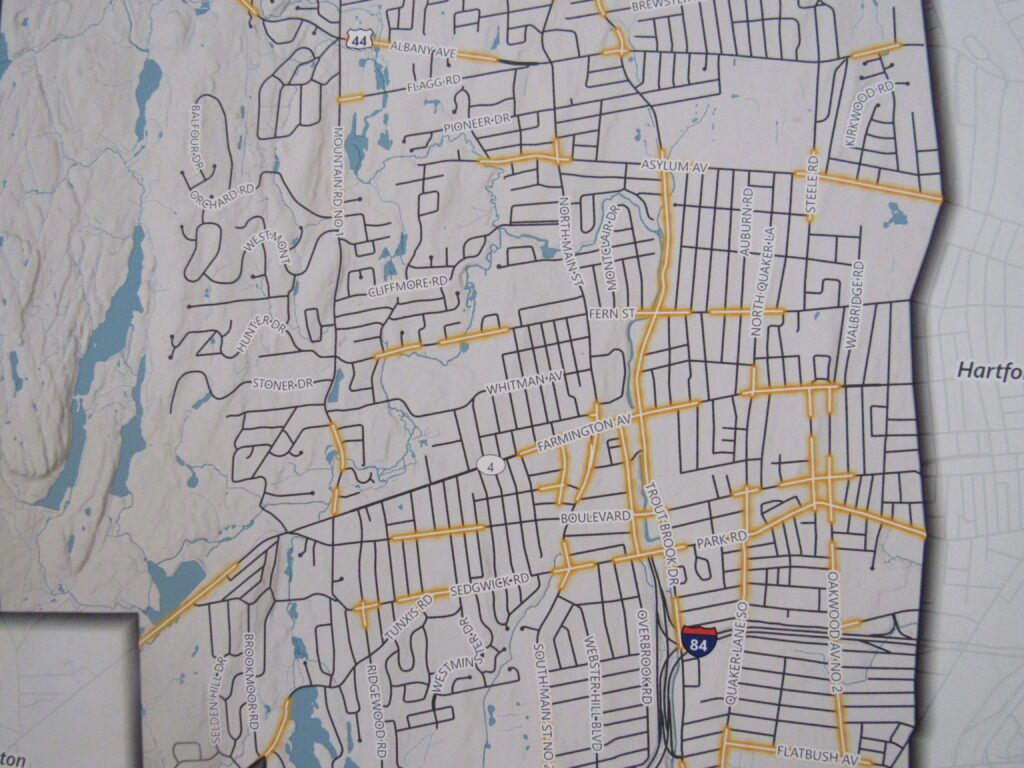
Suggested roads for camera installation based on initial screening results. West Hartford Vision Zero – speed management camera program (public meeting), July 30, 2025. Photo credit: Mia Jaworski
In 2024, West Hartford experienced 365 car crashes resulting in injuries and three pedestrian fatalities, an increase from 326 in 2023 and zero fatalities.
As of mid-2025, the town has reported two traffic-related deaths, both of which occurred in June.
The proposed camera program is expected to be brought before the Town Council in September for final approval before being submitted to the Connecticut Department of Transportation and the Federal Highway Administration.
Cameras to Encourage Safer Driving
West Hartford’s Speed Management Camera Program, part of an 18-month pilot funded by a federal Safe Streets and Roads for All (SS4A) grant, will allow for the installation of up to 15 cameras across town. These cameras, officially known as Automated Traffic Enforcement Safety Devices (ATESDs), will monitor and record speeding and red-light violations in designated areas including school zones, intersections, pedestrian safety zones, and other high-risk roadways.
Under state law (House Bill 5917, signed in June 2023), these devices are authorized to take a photograph of a license plate, along with the date, time, and location of the violation. Violations will be issued to the registered owner of the vehicle not the driver.
The Town of West Hartford has received a $669,007 federal Safe Streets and Roads for All (SS4A) grant for the speed management pilot program, and the Town Council passed an ordinance this spring permitting automated enforcement of speeding as well as red light violations.
Questions about vehicle ownership were raised during the meeting, as attendees sought clarity on what happens when someone other than the owner is behind the wheel. Officials emphasized that the violation notice is tied strictly to the vehicle’s registration, not the individual operating it at the time of the offense.
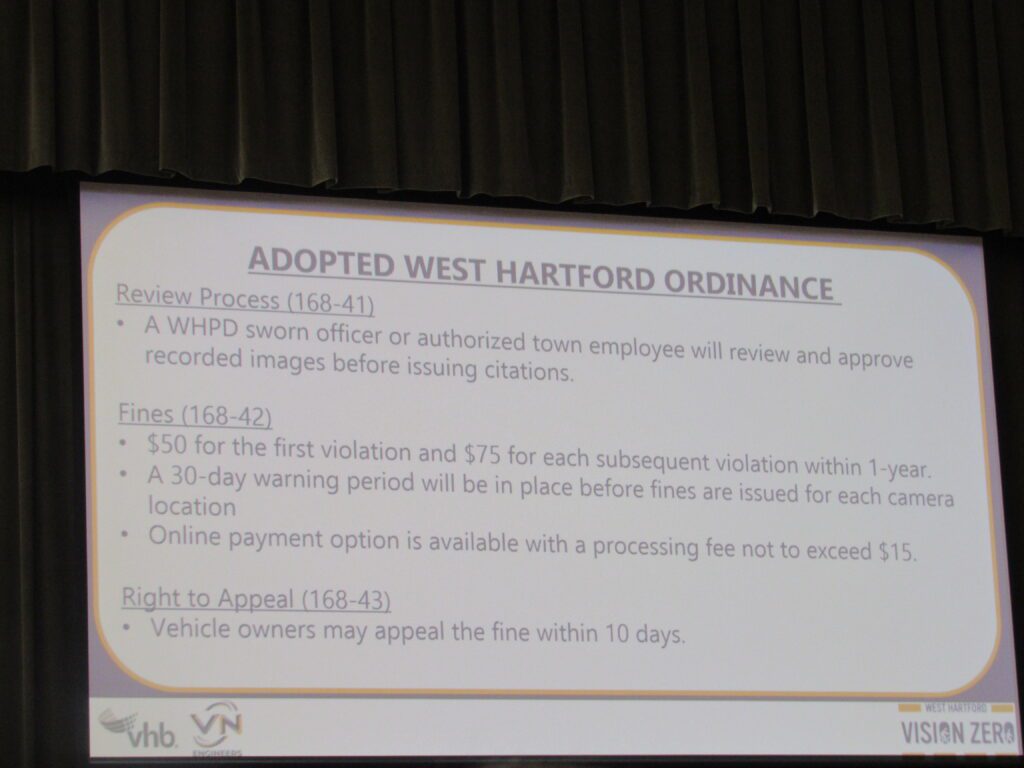
West Hartford Vision Zero – speed management camera program (public meeting), July 30, 2025. Photo credit: Mia Jaworski
Fines, which are set by the state will start at $50 for a first offense (10 mph or more over the speed limit), and $75 for a second violation within one year, plus an administrative fee of $15.
“You can receive several offenses in one drive,” explained Town Manager Rick Ledwith. “Everything will go directly back into keeping our streets safe.”
The cameras are not intended to replace, but rather to supplement, the work of police officers. Ledwith has noted that the police chief refers to the program as a “force multiplier” which gives officers the opportunity to deploy more enforcement efforts in other locations.
The automated traffic enforcement program allows for a citation to be issued when a driver exceeds the posted speed by 10 or more miles per hour, or in the future, when the red light cameras are installed, will allow for citations to be issued when a driver fails to stop for a red light. The cameras activate when a violation occurs, but a human – either a sworn police officer or other official designee – must review the images prior to issuance of a citation.
Vehicle owners may appeal the fine within 10 days, and will be granted a 30-day warning period before fines are issued for each camera location.
Town officials also addressed privacy concerns, assuring residents that the camera systems will not collect personal or identifiable information. The sole purpose of the program, they said, is to improve safety – encouraging drivers to follow the speed limit and stop at red lights throughout town.
The citations are not moving violations nor are they reflected on driving records or tied to the ability to register your car.
What is Vision Zero?
West Hartford’s camera program is part of a growing national movement toward Vision Zero, a policy framework adopted by cities across the country to eliminate traffic deaths and severe injuries.
The town’s efforts align with the goals of the Vision Zero Network, a nonprofit collaborative that helps local governments develop safer, more equitable transportation systems.

Vision Zero. Courtesy photo.
Across the country, communities are beginning to see results from similar initiatives. According to the Vision Zero Network, cities like Seattle have achieved a 48% decrease in crashes involving turning vehicles and pedestrians and a 34% reduction in serious and fatal collisions at intersections where safety improvements have been made.
Vision Zero Network representatives highlighted these successes during the recent NACTO Designing Cities conference in Washington, D.C., where leaders from cities like Oakland, Cleveland, Arlington, and San Antonio shared their progress toward safer streets.
As of late July, five Connecticut municipalities have received approval to install automated traffic cameras. According to a report in the Hartford Courant, the small town of Marlborough issued 1,094 citations in the first two weeks, resulting in fines of nearly $55,000.
Middletown deployed its program in early June, with only the unit on Washington active at this time. According to the city’s website, in the past three weeks following the 30-day grace period there have already been 9,819 citations issued – resulting in $606,000 in fines, of which $30,790 has already been collected.
Community Support, Questions and Concerns
Tuesday’s public meeting drew a mix of support and skepticism. Some residents raised concerns about the accuracy of automated enforcement and the fairness of issuing tickets to vehicle owners rather than drivers.
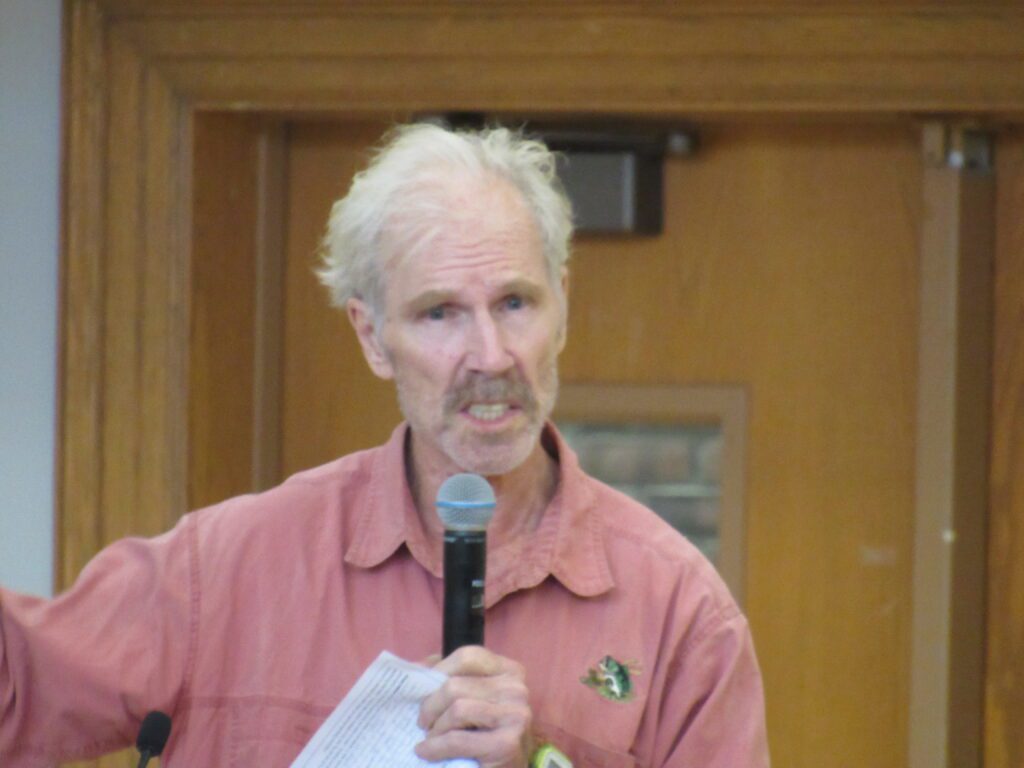
West Hartford Vision Zero – speed management camera program (public meeting), July 30, 2025. Photo credit: Mia Jaworski
Terri Glynn, a resident of Fernridge Road who has lived in town for 26 years, asked, “How do you prove your innocence?” Another attendee, Louis Velazquez, questioned the enforcement process: “Is our tax dollar going to fund the following up of these people?”
Others, however, applauded the initiative. “The only way they’re going to stop is to hit them in the wallet,” said one attendee from Ravenwood Road. Several residents from Flagg Road and Ridgewood Road – streets being considered for camera placement – expressed support for the proposal.
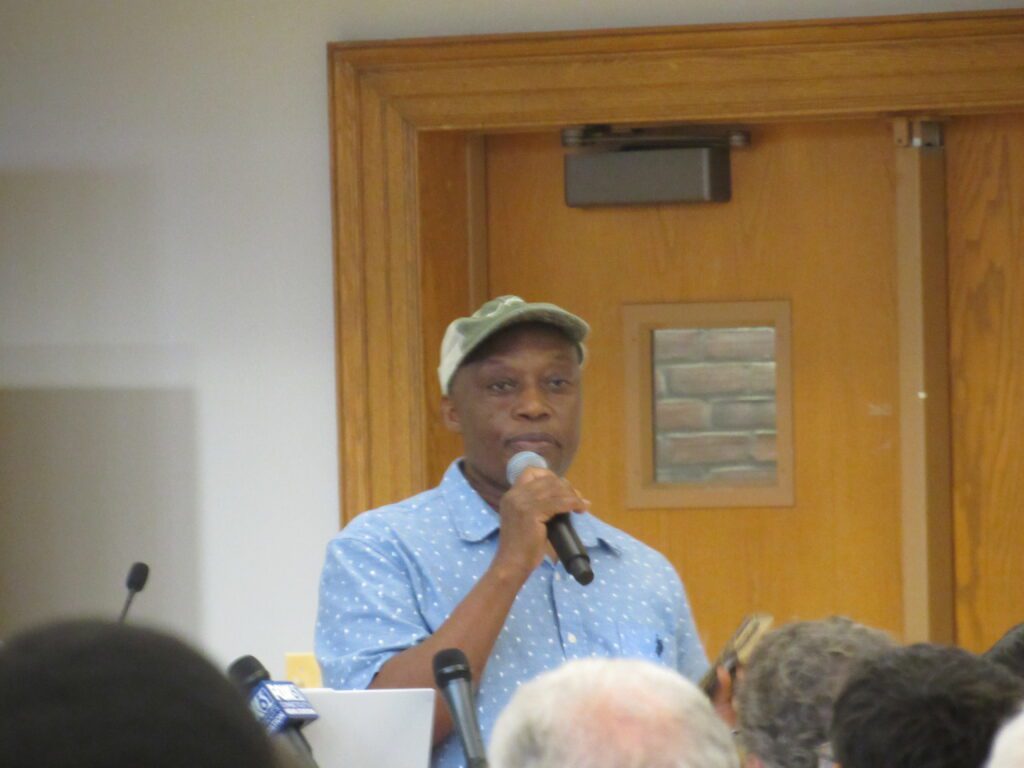
West Hartford Vision Zero – speed management camera program (public meeting), July 30, 2025. Photo credit: Mia Jaworski
Police Chief Vernon L. Riddick Jr. reminded attendees that West Hartford is a regional hub, with many drivers who are not town residents. “West Hartford is a destination. People come here. So keep that in consideration,” he said.
Data-Driven Screening Process
Officials detailed the extensive data collection and screening methodology behind the program. Using GIS mapping, they evaluated every roadway segment in town against criteria including crash history, traffic volumes, average speeds, and vulnerable road users (VRUs) – such as children, seniors, and pedestrians near schools and parks.
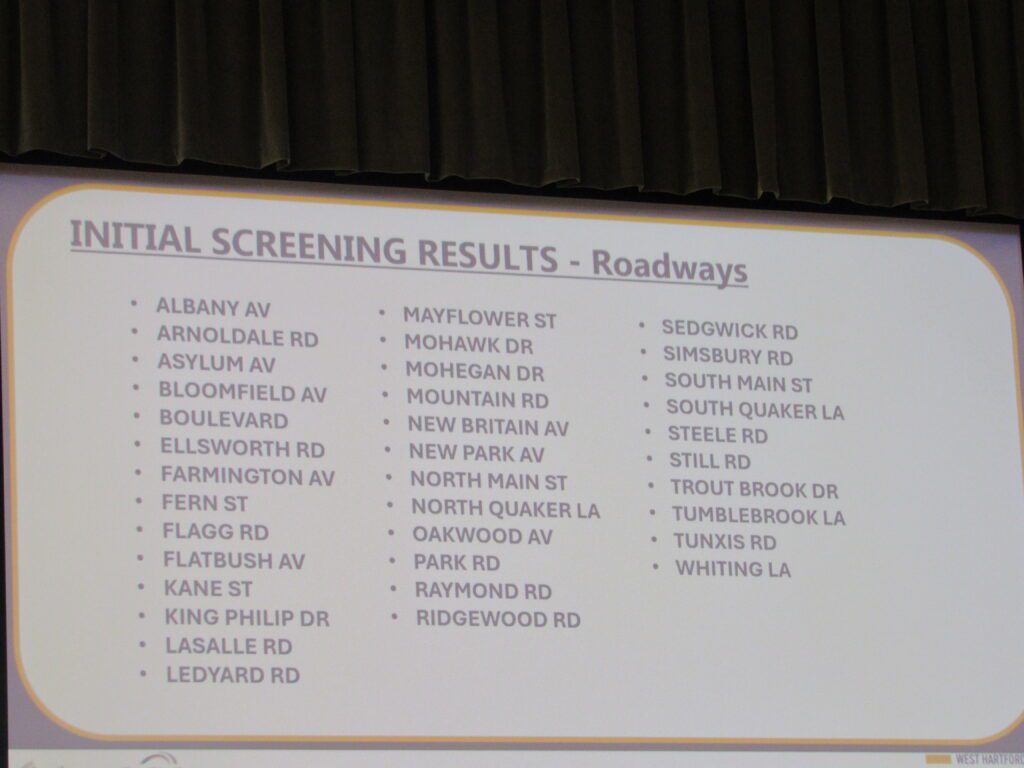
Suggested roads for camera installation based on initial screening results. West Hartford Vision Zero – speed management camera program (public meeting), July 30, 2025. Photo credit: Mia Jaworski
Initial results identified just over three dozen roadway segments as potential camera sites. From among the top 40 locations, the 15 where cameras will be placed will be finalized after additional analysis and public input, including at a second public meeting planned for Sept. 3, 2025, from 6 to 8 p.m. at Sedgwick Middle School.
The cameras will report not only the number of violations but also data on crashes, the revenue generated, and what percentage of fines came from residents versus non-residents.
“Fine numbers are excessive in other states – we may see that here,” Ledwith acknowledged.
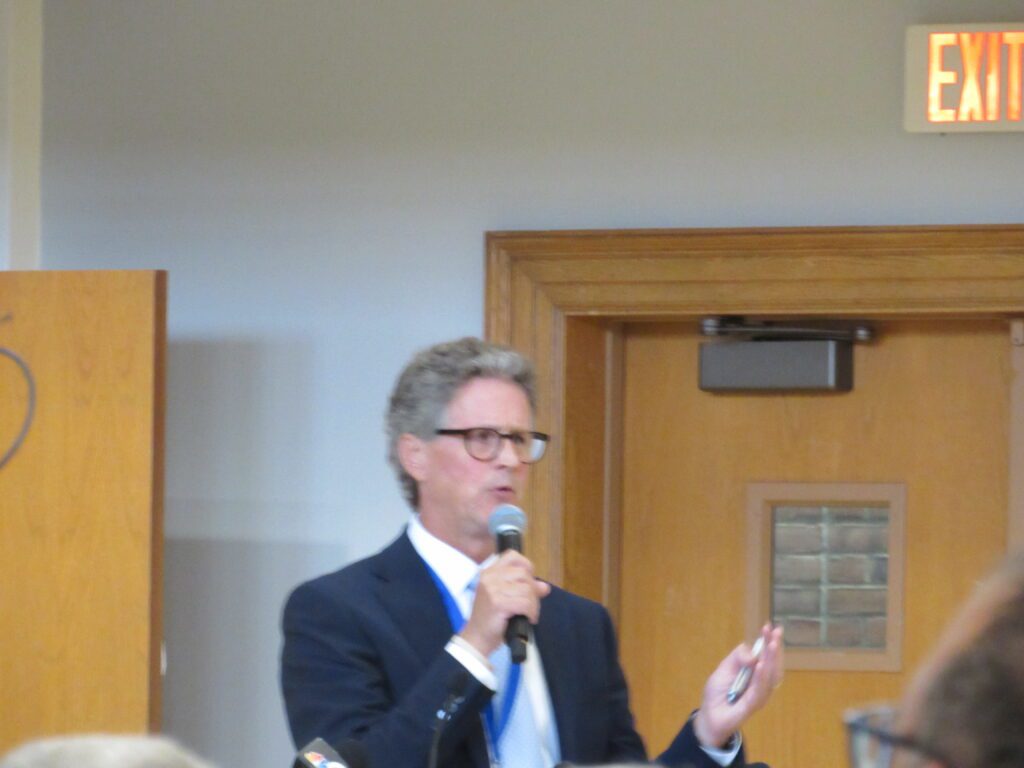
Town Manager Rick Ledwith speaks to the crowd at a public forum on July 30, 2025. West Hartford Vision Zero – speed management camera program (public meeting), July 30, 2025. Photo credit: Mia Jaworski
Before any cameras go live, the town must hold a second public hearing, secure Town Council approval, and receive state approval from the Office of the State Traffic Administration (OSTA). The town must also implement a public awareness campaign 30 days prior to activating the cameras.
The town-wide public awareness campaign will include signage at camera locations and notifications through navigation apps such as Waze and Google Maps.
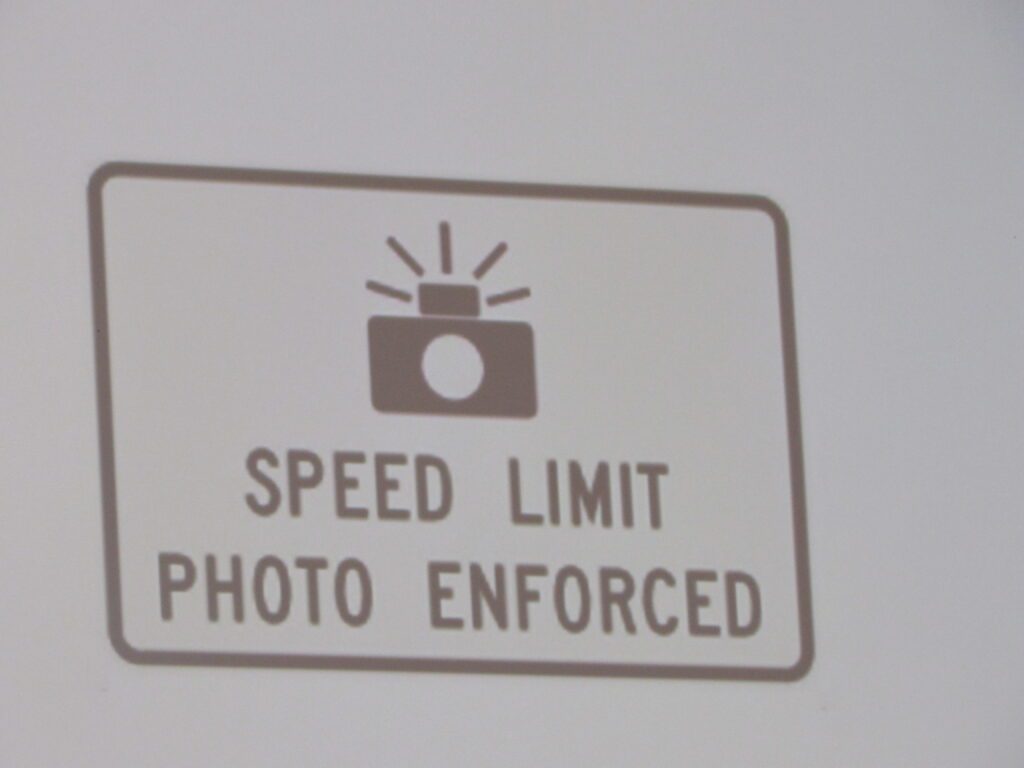
Sign to the placed next to the speed cameras. July 30, 2025. Photo credit: Mia Jaworski
Next Steps
Red-light cameras are still pending a separate agreement and will go through their own public process at a later date. Currently, the town does not have details about the specific camera equipment, as the project has not yet gone out to bid.
Officials emphasized that privacy safeguards will be in place. No personal or identifiable information will be collected, and the sole purpose of the cameras is to improve safety – encouraging drivers to obey speed limits and stop at red lights.
Violations captured by the cameras would be treated as traffic infractions in court, not criminal offenses. Officials also stressed that the program is not intended to replace police officers but to serve as a “force multiplier” in promoting safer streets.
Officials noted that the program will comply with federal civil rights and environmental review requirements, including Title VI of the Civil Rights Act and the National Environmental Policy Act (NEPA).
The next public information session is tenatively scheduled for Sept. 3 at Sedgwick Middle School.
“If all goes as planned, this time next year, we will be installed,” Ledwith said Wednesday.
More information on the progress of West Hartford’s Vision Zero initiative can be found here.
To view the complete presentation present at the July 31, 2025 meeting, click here. The meeting is also available on YouTube.
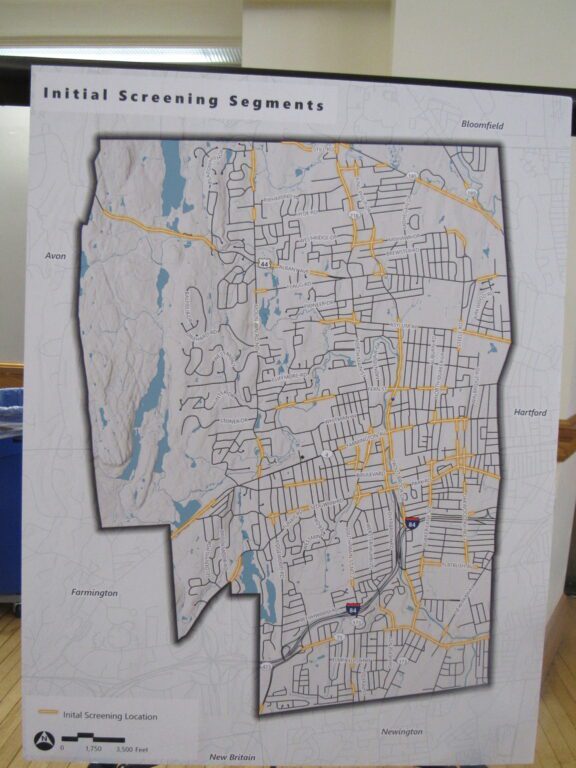
Initial screening segments provided by West Hartford Vision Zero – speed management camera program (public meeting), July 30, 2025. Photo credit: Mia Jaworski
Like what you see here? Click here to subscribe to We-Ha’s newsletter so you’ll always be in the know about what’s happening in West Hartford! Click the blue button below to become a supporter of We-Ha.com and our efforts to continue producing quality journalism.

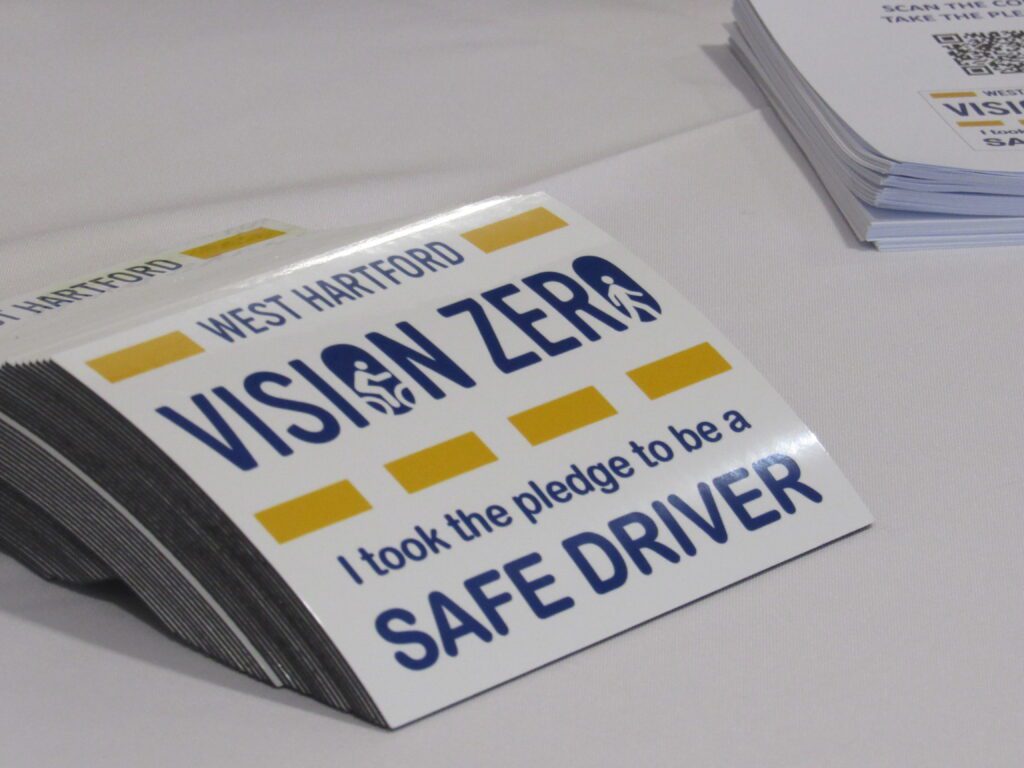


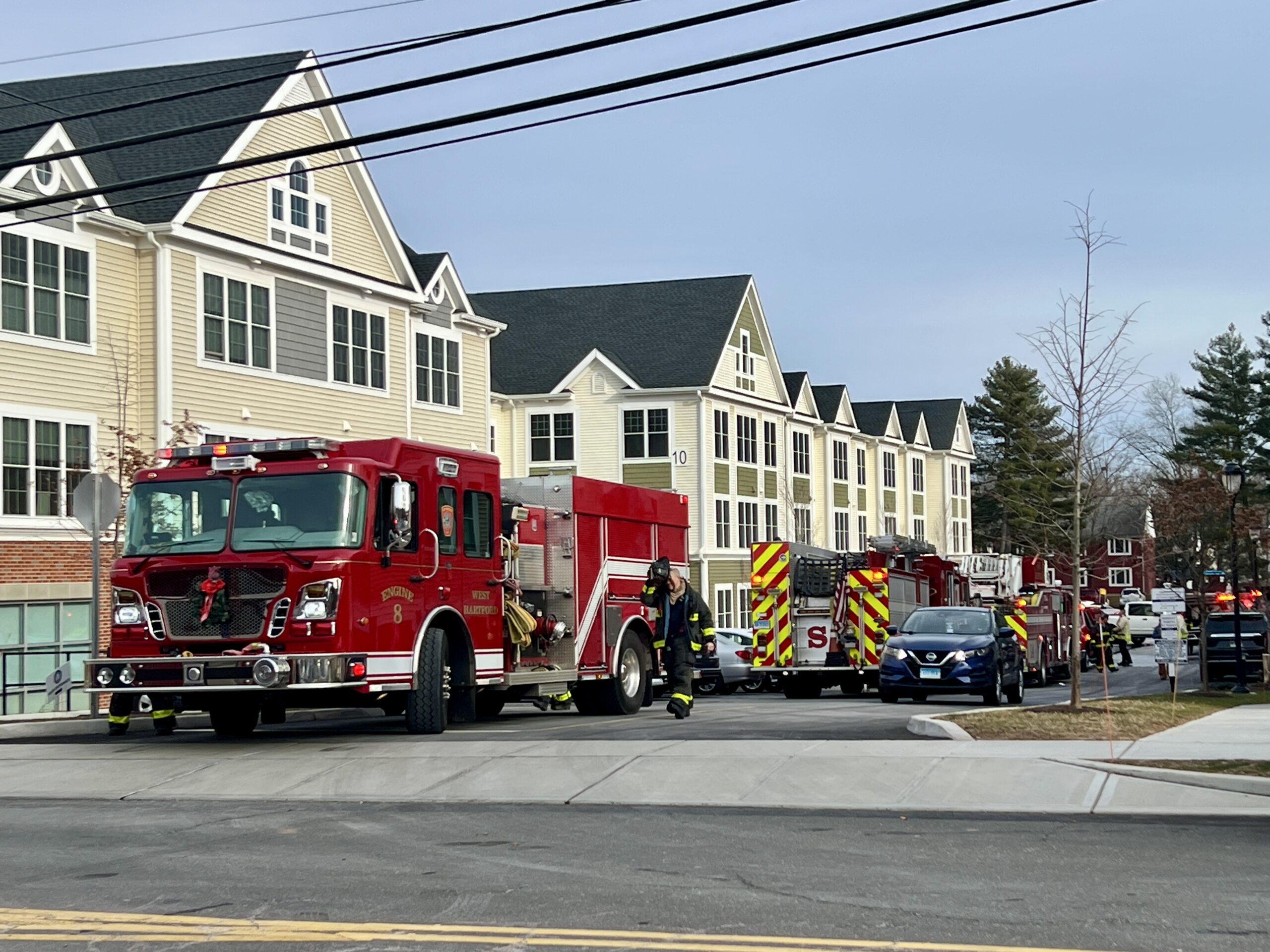
Dear Editor:
I’m 100% in agreement for traffic cameras in the Town of West Hartford. We have way too many inattentive drivers or drivers who see themselves as privileged and need not pay attention to posted speed limits, traffic lights and especially pedestrians. My question is who will receive the funds generated by these traffic fines, the state or the Town of West Hartford? Will West Hartford be held liable for maintenance of cameras and or replacement?
Hi Patrick – The town will receive the funds generated by the speed (and red light) cameras. It’s my understanding that the town will be purchasing the cameras through a grant so I would think the town will likely be responsible for the maintenance of the cameras. Based on results in other towns, the program will likely generate enough revenue to cover any costs incurred. ~Ronnni
Shame on everyone involved in this.
Total govt surveillance in the age of Republican fascism brought to us by democrats like Slapp and the Dem controlled town council.
Are there any Dems willing to stop this who want my vote next election?
24-7-365 govt surveillance is a mistake we will regret.
These cameras violate the 6th Am. The council try to get around this by only issuing civil fines.
The fines are on a “may” issue basis. That means there will be no fines for police and town councilors and other powers that be.
A large percent of the fine money generated will go out of state and maybe even out of country to wherever the camera owners are located.
This is a pure cash grab by the council.
Putting in fixed cameras does nothing to prevent speeding anywhere they aren’t.
Mailing out fines months later to the car owners, and not the driver at fault, does nothing to help safety in the moment.